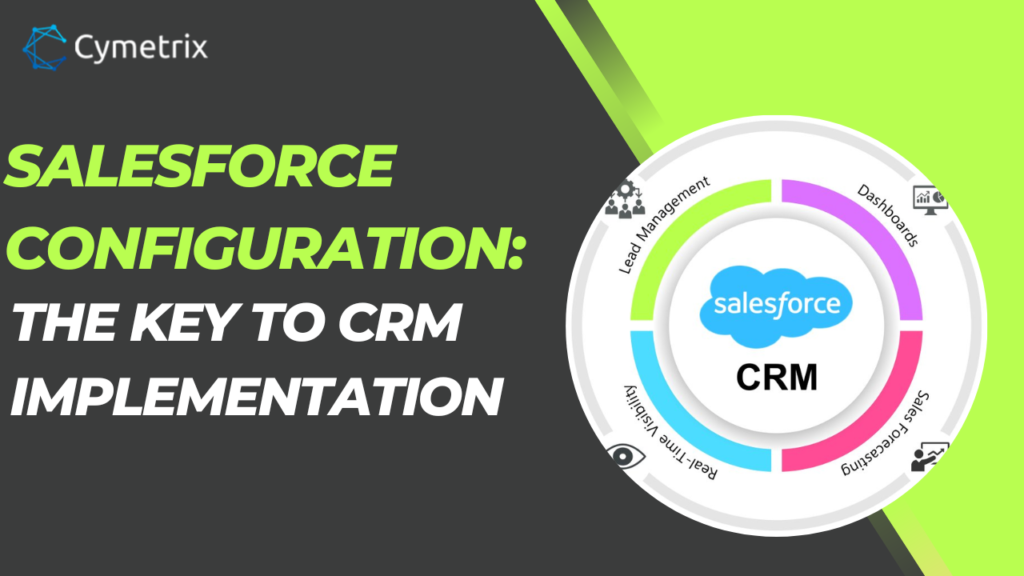
Salesforce is one of the most seamless Customer Relationship Management (CRM) tools available today. However, to make the most of Salesforce, you should configure it to meet your business needs. Salesforce configuration is a process of customizing the platform to align with your business requirements, including automating workflows, customizing fields and objects, and managing data and security.
So, now we will explore how Salesforce configuration is the key to a successful CRM implementation. We will discuss the benefits of Salesforce configuration, the primary elements involved in the process, and the best practices. By the end of this blog post, you will understand how Salesforce configuration can streamline your business processes. As well as, increase productivity, and improve user adoption rates, leading to a successful CRM implementation.
What is Salesforce Configuration?
Salesforce configuration is the process of customizing the Salesforce platform to align with your specific business requirements. It involves setting up and configuring various components, such as automating workflows and customizing fields and objects. Along with, managing data and security, and creating reports and dashboards. Salesforce configuration is an essential aspect of CRM implementation, as it ensures that the platform is customized to meet the unique needs of your business.
It is essential to understand the difference between Salesforce Configuration and Customization. While configuration involves setting up and configuring the platform using its existing features and functionality, customization involves creating new functionality or changing existing features to meet specific business needs.
Benefits of Salesforce Configuration
Salesforce Configuration offers several benefits that can help streamline business processes and increase productivity. Let’s take a look at some of the advantages of Salesforce Configuration:
- Streamlined Business Processes: Salesforce Configuration can help automate workflows, reducing the need for manual intervention and streamlining business processes. For example, you can set up rules to automatically assign leads to the sales team or create workflows to notify team members when a new opportunity is created.
- Increased Productivity and Efficiency: With configuration, you can customize the platform to meet your business needs, making it easier for your team to work efficiently. For example, you can create custom fields and objects to track information specific to your business, reducing the need for manual data entry and minimizing errors.
- Improved User Adoption Rates: By configuring Salesforce to meet the unique needs of your team, you can increase user adoption rates. When the platform is customized based on your team’s needs, they are more likely to use it regularly and get value from it. For example, you can customize the user interface to include only the fields and objects your team needs. So, that would make it easier for them to find the information they need.
- Customized User Interface and User Experience: Salesforce Configuration allows you to create a custom user interface and user experience for your team. Thus, making it easier for them to work with the platform. For example, you can create custom home pages, build custom navigation menus, and configure dashboards and reports. That can provide the information your team needs to make informed decisions.
Best Practices for Salesforce Configuration
When it comes to Salesforce configuration, several best practices can help ensure a successful implementation. Let’s take a look at some of these best practices:
Define Your Requirements
Before configuring Salesforce, you must define your requirements and understand how the platform can meet your business needs. That involves identifying business processes, data requirements, and user needs. For example, you may need to configure Salesforce to track leads, opportunities, and customer data, and automate workflows.
Start Simple
When configuring Salesforce, it’s crucial to start with a simple configuration and gradually add complexity as needed. That allows you to ensure that the configuration is stable and functional before adding more advanced features. For example, you may start by configuring basic objects such as accounts and contacts and then gradually add custom fields, objects, and workflows as needed.
Use Standard Features
Whenever possible, Salesforce provides many standard features necessary to meet business needs. Whenever possible, it’s best to use these standard features instead of creating custom solutions. It helps to ensure that your configuration is efficient, maintainable, and scalable. For example, you may use Salesforce’s standard lead assignment rules instead of creating custom workflows to assign leads.
Test Your Configuration
Before deploying your configuration, it’s essential to test it thoroughly to ensure that it is stable and functional. That involves testing all workflows, data validation rules, reports, dashboards, user interfaces, and user experiences. For example, you may need to test your lead assignment rules by creating test leads and verifying that they are assigned correctly.
Maintain Your Configuration
Maintaining your Salesforce Configuration involves regularly reviewing and updating it to ensure that it continues to meet your business needs. It includes updating data validation rules, workflows, and reports as your business processes evolve. It also involves monitoring user adoption rates to make adjustments and ensure that your team leverages the platform effectively.
Conclusion
Salesforce configuration is a critical aspect of CRM implementation that can make or break the success of your platform. By customizing Salesforce to meet your unique business needs, you can increase productivity, streamline business processes, and gain valuable insights into your business’s performance. At Cymetrix, we understand the importance of configuration and are committed to providing comprehensive solutions. That will enable your business to leverage the platform to its full potential.
Whether you are just starting with Salesforce or looking to optimize your existing configuration, our team of experts can help you design and implement a tailored solution that meets your business needs. Contact us today to learn more about our Salesforce consultant services and take the first step toward a successful CRM implementation. You can continue to read more about such intriguing topics, check out our blog for more.
